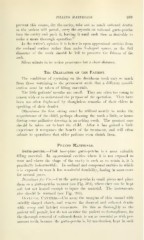Page 671 - My FlipBook
P. 671
FILLING MATERIALS. 669
prevent this course, dry the cavity, take out as much softened dentin
as the patient will permit, carry the crystals on softened gutta-percha
into the cavity and pack it, leaving it until such time as desirable to
make a more thorough operation."
In the writer's opinion it is better to open approximal cavities from
the occlusal surface rather than make V-shaped spaces, as the full
diameter of the teeth should be left to preserve the fulness of the
urch.
Silver nitrate in its action penetrates but a short distance.
The Character of the Patient.
The conditions of operating on the deciduous teeth vary so much
from those pertaining to the permanent teeth that a different consid-
eration must be taken of filling materials.
The little patients' mouths are small. They are often too young to
reason with or to understand the purpose of the operation. They have
been too often frightened by thoughtless remarks of their elders in
speaking of their dentist.
Oftentimes the first sitting must be utilized merely to make the
acquaintance of the child, perhaps cleaning the teeth a little, or intro-
ducing some palliative dressing in an aching tooth. The greatest care
should be taken not to hurt the child. After it has gained a little
experience it recognizes the benefit of the treatment, and will often
.submit to operations that older patients even shrink from.
Filling Materials.
Gutta-percha.—Pink base-plate gutta-percha is a most valuable
filling material. In approximal cavities where it is not exposed to
wear and A\here the sha})e of the cavity is such as to retain it, it is
practically indestructible. In occlusal and compound cavities in which
it is exposed to wear it has wonderful durability, lasting in some cases
for several years.
Directions for Use.—Cut the gutta-percha in small pieces and place
them on a gutta-percha warmer (see Fig. 304), where they can be kept
soft but not heated enough to injure the material. The instruments
also should be warmed (see Fig. 293).
Occlusal Cavities.—Cut away the margins of thin enamel with
suitably shaped chisels, and remove the decayed and softened dentin
with scoop and hatchet excavators. Do this as thoroughly as the
patient will permit, but do not sacrifice the patient to thoroughness, for
the thorough removal of softened dentin is not as essential as with per-
manent teeth, because the gutta-percha is, by mastication, kept in such


